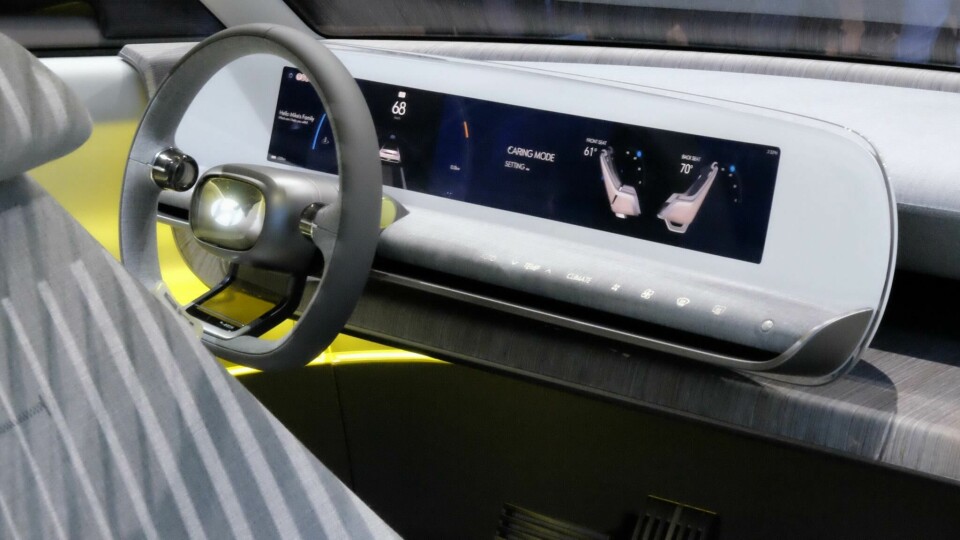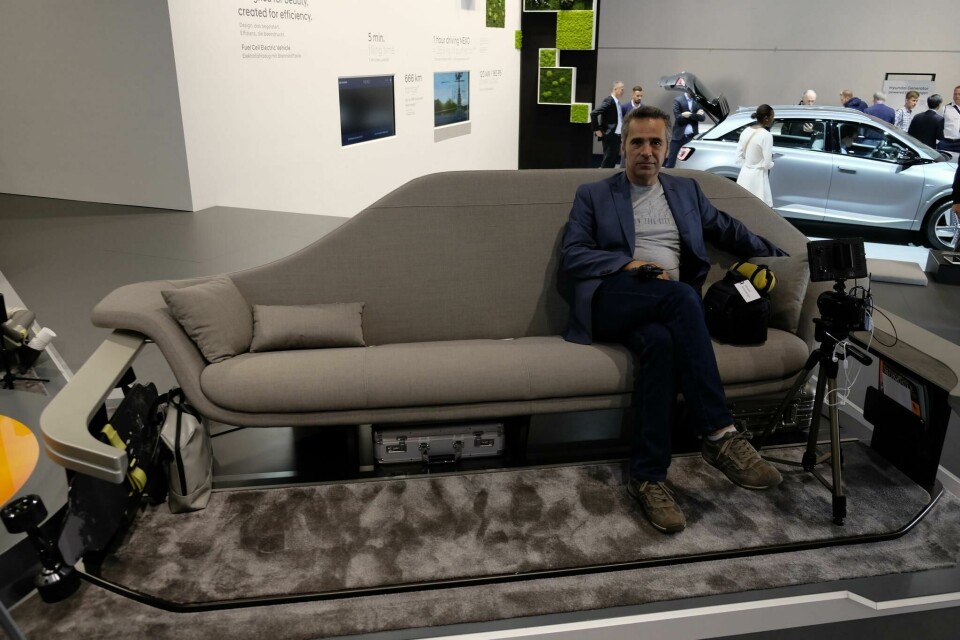
Design Analysis: Hyundai 45 & H-Space concepts
Taking a closer look at Hyundai’s two-stage vision of the future
Hyundai Concept 45
45 years is a long time in the automotive world, especially in the current environment of break-neck technological advancement and epic shifts in attitudes towards car ownership. So while we often like to think of Hyundai as one of the new kids on the automotive block, the 45 concept first shown at IAA Frankfurt reminds us instead of the company’s rather significant heritage, while also serving as a stepping stone to a vision of the future that was also on display.
The 45 concept, as its name suggests, celebrates 45 years since the ItalDesign-designed Pony Coupé concept, a car that announced the Korean company’s intentions on the global stage with Italian style, was introduced at the Turin Motor Show. That original concept didn’t directly translate into production, and neither will the 45, but both set the tone for cars to come, if new Head of Hyundai Styling Group, Simon Loasby, has anything to say about it.
The exterior of the 45 is a massive departure from what we’ve seen before from the Hyundai design team. The sliding coach-door hatchback takes cues from both the original concept and from the number 45. Strong geometric forms reminiscent of Giugiaro’s original 1970s car are broken up with 45-degree angles to create a patchwork of taut surfaces, that do a very good job of creating a more modern visual language than a more literal retro design would have done.
The front and rear lighting is created with a series of small light blocks that give a clear “Space Invaders” 8-bit vibe while still looking completely of-the-moment. Other details, such as the flush Hyundai logo in the hood and pyramidal rear-view cameras, reinforce the retro-modern look further, but never to the point of being direct reinterpretations.
But as new and different as the exterior design is compared to what we’ve come to expect from Hyundai, the interior is even more surprising.
The huge sliding doors reveal an interior that represents a huge shift in character for the brand. Almost Scandinavian in style, the light colours, soft forms and natural fabrics signal a calm maturity that references the Le Fil Rouge concept in architecture, but with much more refinement and simplicity.
Beyond the visual maturity, there is a philosophical one as well. The interior materials have been meticulously chosen for their sustainability. Leather tanned using olive leaves; natural wool seats, bent wood IP and seat backs, and even a natural-resin light bar wrapping around the entire lower part of the car signal Hyundai’s desire to up their eco credentials, with very good effect. The visual impact is of a softer, friendlier, more European-premium environment than the usual Korean offering – which played well with the Frankfurt crowd upon the 45’s debut.
The IP is designed to be modular, so instead of the all-too-common retractable autonomous steering wheel, the 45 has an actual driving position, but with an incredibly minimalist IP that looks somewhat like a giant white-backed tablet computer with a steering wheel sticking through it. The idea is that if autonomous driving does come about, the IP can be eliminated altogether, leaving nothing but a spacious, open interior architecture. Being a concept, however, the car does have rotating seats to facilitate both different modes of use as well as passenger interaction and in/egress.
Hyundai H-Space concept
The 45’s less-than-futuristic solution is actually somewhat refreshing in a sea of impossible AV concepts, but makes even more sense in light of Hyundai’s second concept shown at IAA: the H-Space.
Brochure images for the Hyundai H-Space concept
Designed for a future of full autonomy, the H-Space is an interior concept without a car – fitting for a future vision of driving where ownership is secondary to experience. The interior is designed to be hot-swappable, with three possible configurations shown on the Frankfurt stand called “Me”, “Beyond”, and “Us”. According to the design team, many different layouts were considered and tested, with the three on show being the most interesting of the three, but far from the only choices.
The layout that was shown inside the ‘car’, called “Me”, is perhaps the most conventional of the three, with two highly-adjustable lounge seats centrally placed and facing forwards. This layout uses an AI to create an atmosphere that enhances comfort and responds to passengers’ moods. A simple touchscreen interface between the two seats asks a short series of questions to gauge how the passengers feel, with each passenger prompted to give a response. Then an optimal theme is created by the system, complete with lighting, seating position and enveloping full-screen imagery on the transparent-OLED windows.
By sharing the input, the users inherently are also sharing an experience, rather than having their own personalised configuration, which is a curious choice in a two-seat autonomous transport called “Me” that is described as being “optimised only for myself” with an “individually optimised experience”. Ultimately though, it serves to bring two people together in both physical and mental space, which will certainly be one of the challenges of this sort of layout in the future.

The second option is, for lack of a better description, a sofa. But this sofa is designed to make a commuters’ shared experience more pleasant. Called “Beyond”, this layout is designed by Hyundai to be a fully shared space that brings the community together. By placing the sofa sideways, the effect is to give easy access through the single huge door opening; essentially creating an easy step-in setup that isn’t entirely unlike a very luxurious metro or bus, but with door-to-door capabilities.
An interesting counterpoint to concepts such as Renault’s EZ-Go or Mercedes Vision Urbanetic that use lounge seating tucked into the edges of the car to jam large groups around a central plaza, the H-Space sofa can only fit 5-6 passengers. But, by placing it sideways, Hyundai designers have created step-in access to a familiar seating arrangement. That might not seem like a big deal, but efficiency will be crucial to the adoption of shared autonomous vehicles, so making in- and egress easy and quick is very clever.
The third layout is called “Us” and is also a clever take on future automotive use. While both the “Me” and “Beyond” layouts are designed explicitly for better transport, “Us” focuses as much on the destination as the voyage. The set of small, geometrically-shaped seats are designed to face one another while moving, but also to be easy to take out and use as lawn chairs upon arrival. Whether for a picnic, an outdoor concert or simply a relaxing summer evening with friends, the idea of this automotive furniture also extending behind the car is a step that few (since the 2CV) have taken, but is certainly interesting in markets like China or even Europe, where space is precious in cities and a drive to the countryside can be a real respite from the chaos.
But would these cars be privately owned, or exist as part of a shared ecosystem? Are those city dwellers so desperate for an afternoon in the countryside going to want to own a vehicle, or have the space to keep the interior furniture from one in their home? While many carmakers are positing pie-in-the-sky scenarios of autonomous fleets, owned by the company and serviced through goodwill and robots, Hyundai has taken a much more pragmatic approach to the problem. They believe that AV usership will be more than just shared public vehicles, and that private ownership will continue to be a part of the equation. They foresee interior furniture from brands such as Vitra or IKEA being designed to match their platform and customer’s homes. While it’s unclear how they would be fitted, the idea of personally-owned interior elements being mounted into a shared or managed AV is an interesting one.
Hyundai also sees themselves as a potential partner for ride-hailing and coworking companies as they transform into a ‘mobility services company’. Hyundai might provide the automotive infrastructure while the ride-hailing or sharing company manages the rides and spaces themselves. For office sharing, the adjustable and removable interior furniture would give flexibility and variability that other AV taxis might not, as well as the potential to shift supply based on demand for other services (something a big player could support, but individual small companies could not).
***
Using a manufacturer’s substantial weight and breadth to support startups and piggyback off established brands shows that Hyundai is not content to simply sit back and reflect on the last 45 years, but is actively looking to the future. The details may not yet be entirely clear, but the desire to change and move forwards is. Based on Hyundai’s recent management changes and the concepts we’ve seen recently, we don’t suspect anyone will be dismissing the Korean brand as they did in Turin 45 years ago – and we get the sense that they wouldn’t have it any other way.













































